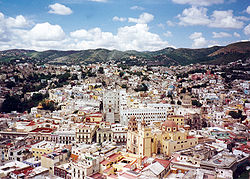Guanajuato (city): Difference between revisions
No edit summary |
No edit summary |
||
| Line 15: | Line 15: | ||
The city was originally built over a river, which flowed through tunnels underneath the city. However, after years of raising buildings to accommodate repeated flooding, in the mid-twentieth century, engineers built a dam and redirected the river into underground caverns. The tunnels were lit and paved with cobblestones for automobile traffic, and this underground road carries the majority of cars driving through the city today. It is one of the most noticeable features of the city. |
The city was originally built over a river, which flowed through tunnels underneath the city. However, after years of raising buildings to accommodate repeated flooding, in the mid-twentieth century, engineers built a dam and redirected the river into underground caverns. The tunnels were lit and paved with cobblestones for automobile traffic, and this underground road carries the majority of cars driving through the city today. It is one of the most noticeable features of the city. |
||
[[Image:Guanajuato mummy 02.jpg| |
[[Image:Guanajuato mummy 02.jpg|right|thumb|250px|Hand of Guanajuato Mummy]] |
||
In the Panteón [[catacombs]] to the west of the city is a famous cemetery noted for the natural [[Mummies of Guanajuato|mummies]] produced by unknown means. About 1 in 100 bodies buried here experience natural [[mummy|mummification]]. In the late 1800s the town instituted a "burial tax" for the families of the deceased. When some of the poorest families were unable to pay the tax, their relatives were dug up and placed on public view in a purpose-built museum. The 'Guanajuato Mummy Museum' still adds corpses to this day; two children were added who died in 1984 most recently due to their relatives' failure to pay the $ 20 per 5 year rental fee. The museum holds 111 corpses resting on velvet pillows. Today, it is reported that the proceeds from the museum help fund the city's coffers to a considerable degree. |
In the Panteón [[catacombs]] to the west of the city is a famous cemetery noted for the natural [[Mummies of Guanajuato|mummies]] produced by unknown means. About 1 in 100 bodies buried here experience natural [[mummy|mummification]]. In the late 1800s the town instituted a "burial tax" for the families of the deceased. When some of the poorest families were unable to pay the tax, their relatives were dug up and placed on public view in a purpose-built museum. The 'Guanajuato Mummy Museum' still adds corpses to this day; two children were added who died in 1984 most recently due to their relatives' failure to pay the $ 20 per 5 year rental fee. The museum holds 111 corpses resting on velvet pillows. Today, it is reported that the proceeds from the museum help fund the city's coffers to a considerable degree. |
||
Revision as of 19:06, 8 July 2006
- Guanajuato is the name of both a state in Mexico and that state's capital city. This article is about the city. For the state of the same name, see state of Guanajuato.

The Mexican city of Guanajuato is the capital of the state of the same name. It is located at 21°02′N 101°28′W / 21.033°N 101.467°W, 370 km (230 miles) northwest of Mexico City, at an elevation of 1,996 m (6,550 ft) above sea level. The estimated population in 2003 was about 78,000 people.
Guanajuato was founded as a town in 1554 and received the designation as a city in 1741. It is located in one of the richest silver mining areas of Mexico, and is well known for its wealth of fine colonial era Spanish architecture.
The historic town and adjacent mines are a World Heritage Site.
The name "Guanajuato" comes from the Tarascan word, "Quanax-juato", which means "place of frogs".

The city was originally built over a river, which flowed through tunnels underneath the city. However, after years of raising buildings to accommodate repeated flooding, in the mid-twentieth century, engineers built a dam and redirected the river into underground caverns. The tunnels were lit and paved with cobblestones for automobile traffic, and this underground road carries the majority of cars driving through the city today. It is one of the most noticeable features of the city.

In the Panteón catacombs to the west of the city is a famous cemetery noted for the natural mummies produced by unknown means. About 1 in 100 bodies buried here experience natural mummification. In the late 1800s the town instituted a "burial tax" for the families of the deceased. When some of the poorest families were unable to pay the tax, their relatives were dug up and placed on public view in a purpose-built museum. The 'Guanajuato Mummy Museum' still adds corpses to this day; two children were added who died in 1984 most recently due to their relatives' failure to pay the $ 20 per 5 year rental fee. The museum holds 111 corpses resting on velvet pillows. Today, it is reported that the proceeds from the museum help fund the city's coffers to a considerable degree.
The city of Guanajuato was the birthplace of artist Diego Rivera, whose house is now a museum.
The city also harbours one of the largest places in Mexico for mathematical research, a public institution dubbed CIMAT.
Each October the city holds the Festival Internacional Cervantino, an international festival of the arts named after Miguel de Cervantes. The festival is a popular draw for young students from across central Mexico, but attracts participants and spectators from around the world.
Trivia
- The movie Once Upon a Time in Mexico was filmed here. Many of the scenes in the movie feature sights easily recognizable to someone who had been to the city.
